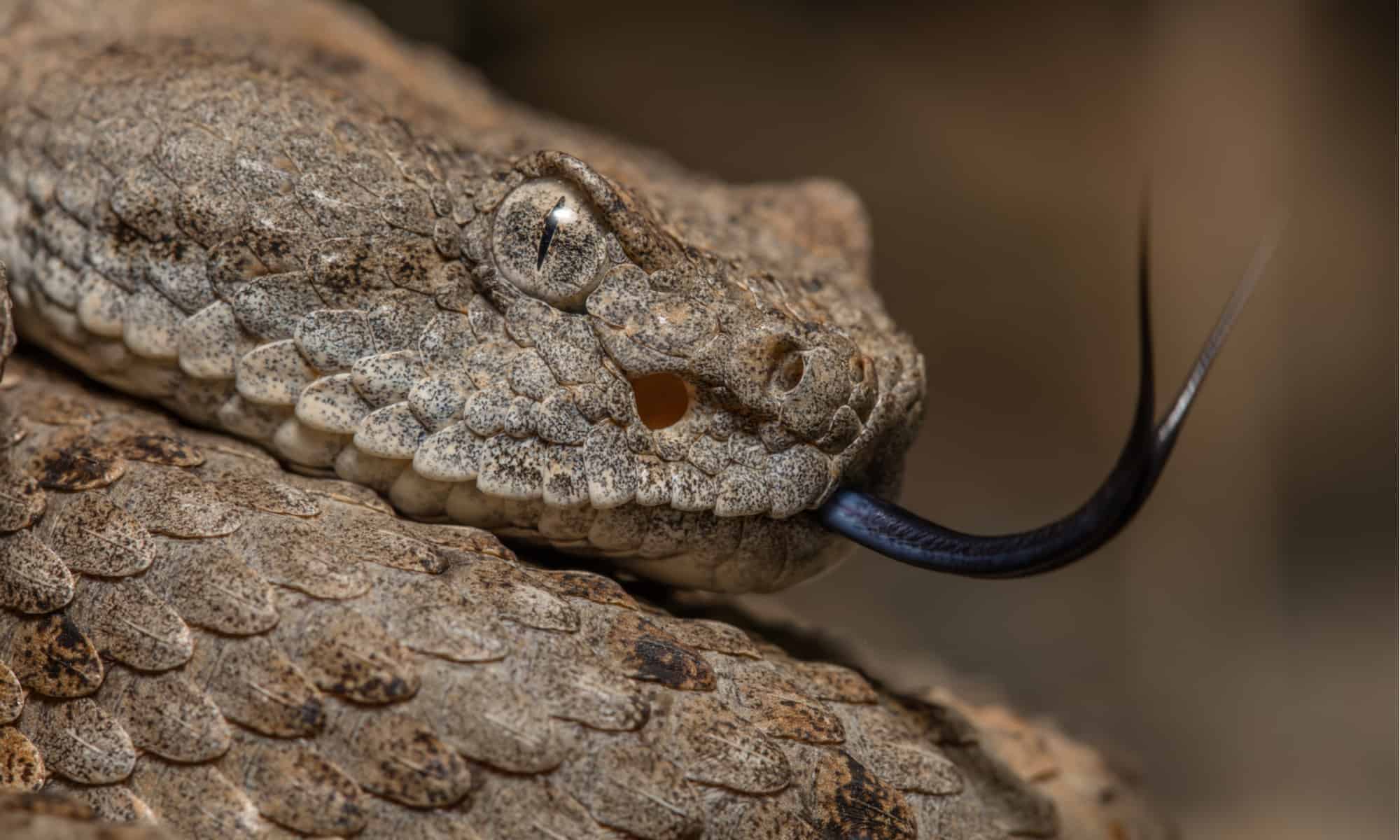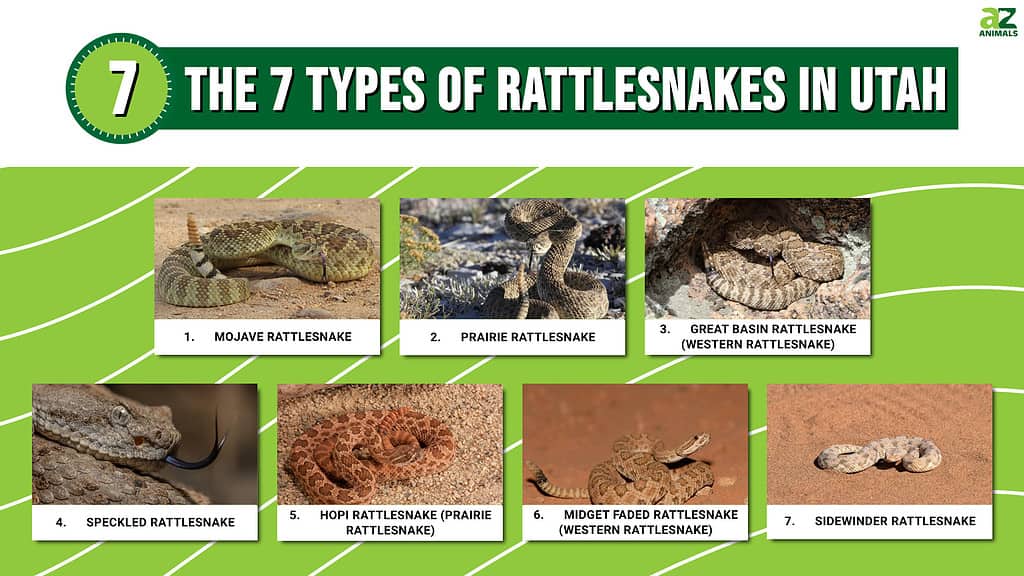
Rattlesnakes in Utah begin emerging from their winter brumation around April, when the weather starts warming up. They remain most active throughout the summer, until the weather begins to turn cold again around September. Many of us see rattlesnakes as something terrifying. True, a rattlesnake bite can be quite dangerous due to the complexity of toxins in their venom. However, rattlesnakes really are not as awful as you might expect. In fact, the rattlesnakes in Utah are non-aggressive, and will only strike if they are threatened or harassed. Most likely you will walk right past a rattlesnake while hiking and never even know it! So, what kinds of rattlesnakes live in Utah?
What types of Rattlesnakes are in Utah?

A rattlesnake will shake its tail when it feels threatened to make a hissing or rattling alarm sound.
©DMartin09/Shutterstock.com
Utah is home to seven different types of rattlesnakes. Six are unique species (as you’ll see, some snakes on this list are “subspecies,” which means they’re different but not quite different enough to be a unique species). Rattlesnakes are protected under Utah law. This means that it is illegal to hunt, kill, or harass any rattlesnake found in Utah. Utah’s rattlesnakes are very important to the environment and ecosystem, helping to keep the rodents population in check. Let’s check out the seven types of rattlesnakes found within the state of Utah.
1. Mojave Rattlesnake (Crotalus scutulatus)

The Mojave Rattlesnake is widely considered the most deadly snake in the United States.
©Creeping Things/Shutterstock.com
| Mojave Rattlesnake | |
|---|---|
| Range | Extreme southwest corner of Utah |
| Length | 39-54 inches |
The Mojave rattlesnake is found only in the extreme southwest corner of Utah. Its habitat stretches from central Mexico through the southwest United States. The Mojave rattlesnake is 39-54 inches long and lives in desert climates with little vegetation where it spends much of its time out in open air.
The Mojave rattlesnake comes in various shades of brown, often with a greenish hue. The Western rattlesnake has a similar appearance, but it lacks this “Mojave” green tinge. The Mojave rattlesnake has a dark diamond pattern running down the middle of its back, with a white band on its tail.
The venom of the Mojave rattlesnake is one of the most dangerous in North America. However, bites can be treated with anti-venom if you get medical attention right away. The Mojave rattlesnake’s potent venom is a neurotoxic-hemotoxic blend, attacking both the nervous system and the circulatory system at the same time.
2. Prairie Rattlesnake (Crotalus viridis)
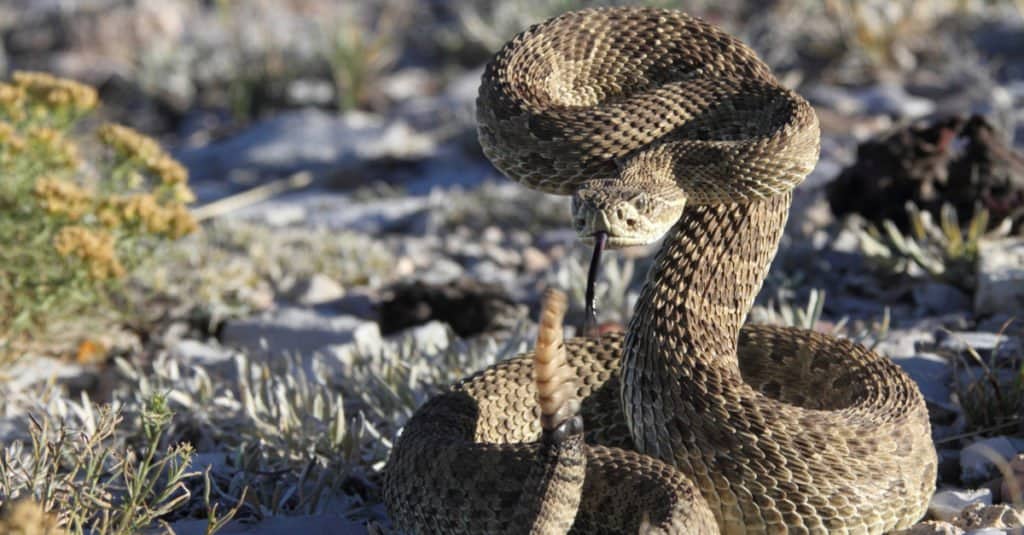
Although prairie rattlesnakes spend most of their time slithering on the ground, they can also climb trees, navigate bushes, and are known to hide in rock crevices or small caves.
©Harris Motion Photo/Shutterstock.com
| Prairie Rattlesnake | |
|---|---|
| Range | Eastern half of Utah |
| Length | 35-45 inches |
The prairie rattlesnake lives in the eastern half of Utah. It is sometimes called the Great Plains rattlesnake since its range covers most of the Great Plains area of North America, southwestern Canada, and northern Mexico. Prairie rattlesnakes are usually more than 3 feet long but can measure anywhere from 35-45 inches.
The prairie rattlesnake is lightly colored, usually in various shades of brown. It has dark brown oval-shaped patches with thin white borders running down the middle of its back. As these patches get closer to the end of their tails, they become dark rings. The scales along the snake’s back are also keeled, so there is a rough ridge in the middle of each scale, giving the snake a rougher, bristly appearance.
Prairie rattlesnakes primarily eat small mammals like mice, ground squirrels, small rabbits, prairie dogs, and rats. Occasionally they will also hunt ground-nesting birds, small reptiles, and amphibians. The venom of the prairie rattlesnake is primarily a hemotoxin, destroying red blood cells. It also has some neurotoxic elements as well that can interfere with cell signaling and cause paralysis. All prairie rattlesnakes have toxic venom from the day they are born, although some scientists argue that the venom composition changes as they age. Regardless, you should always be careful around rattlesnakes, no matter their size or age.
3. Great Basin Rattlesnake (Crotalus lutosis)
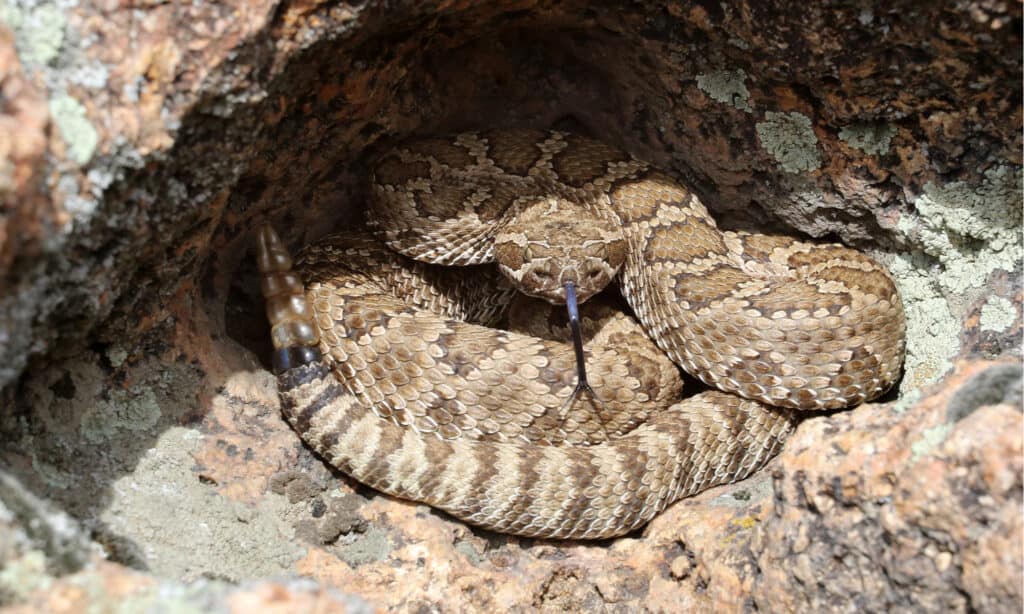
The oldest Great Basin Rattlesnake on record was 19 1/2 years old.
©Randy Bjorklund/Shutterstock.com
| Great Basin Rattlesnake | |
|---|---|
| Range | Western Utah |
| Length | 16-64 inches |
The Great Basin rattlesnake is found in western Utah, favoring areas with agriculture, grassy plains, stony canyons, and rocky hillsides. Its habitat covers much of the Great Basin area of the United States, from which it gets its name. The Great Basin Rattlesnake is a subspecies of the western rattlesnake, ranging in length from 16-64 inches long. Most commonly, however, these snakes are around three feet long.
Great Basin rattlesnakes have stocky, thick bodies and are usually pale gray, olive-brown, light brown, or yellowish-brown in color. Dark blotches with pale centers run along the middle of their backs. Great Basin rattlesnakes are quite helpful to farmers since they eat many animals that damage crops, like rabbits and ground squirrels. These snakes also hunt birds, amphibians, lizards, and other snakes. Their venom contains both hemotoxins and myotoxins, and possibly even neurotoxins.
The Great Basin rattlesnake has a non-venomous look-a-like: the Great Basin gopher snake. The two snakes are similar in color, and the Great Basin gopher snake mimics a rattlesnake by twitching its tail when threatened. Because of their similar appearance and behavior, many hikers unfortunately act out of fear and kill Great Basin gopher snakes, even though they are harmless.
Here are a few ways to tell the difference between the Great Basin rattlesnake and the Great Basin gopher snake:
- The Great Basin rattlesnake has a thicker body and a large triangle-shaped head.
- The Great Basin gopher snake has a thin body with a head shaped like a bullet.
4. Southwestern Speckled Rattlesnake (Crotalus pyrrhus)
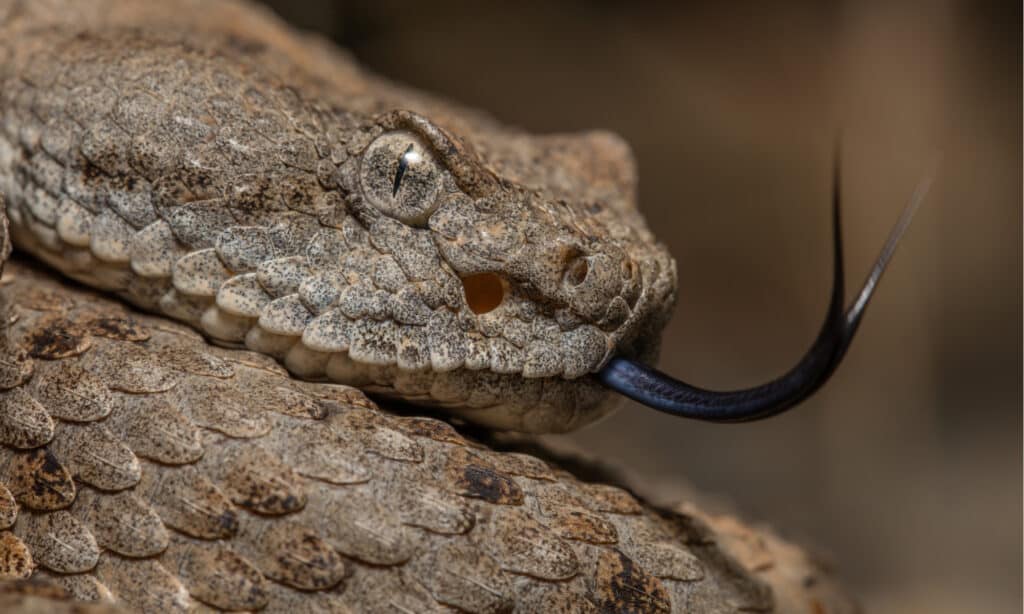
The Speckled Rattlesnake’s venom is twice as dangerous as the western diamondback rattlesnake.
©Alexander Wong/Shutterstock.com
| Speckled Rattlesnake | |
|---|---|
| Range | Extreme southwest corner of Utah |
| Length | 39 inches or less |
The speckled rattlesnake is endemic to the southwestern United States and northwestern Mexico, but it is found only in the extreme southwest corner of Utah. In the U.S. these snakes do not grow longer than 39 inches. Speckled rattlesnakes are light brown or tan in color with small dark bands and colored “speckles” all over their bodies. However, a speckled rattlesnake’s color varies more than other rattlesnakes because their camouflage coloring helps them to blend into their surrounding environment. They can be light brown or tan, but also off-white, gray, pale brown, pale yellow, pinkish-brown, pale orange, etc., depending on where they live.
Speckled rattlesnakes live in desert areas, preferring a combination of sandy, rocky areas mixed with some vegetation like shrubs or conifer trees. The venom of the speckled rattlesnake is neurotoxic, attacking the nervous system and causing paralysis.
5. Hopi Rattlesnake (Crotalus viridis nuntius)
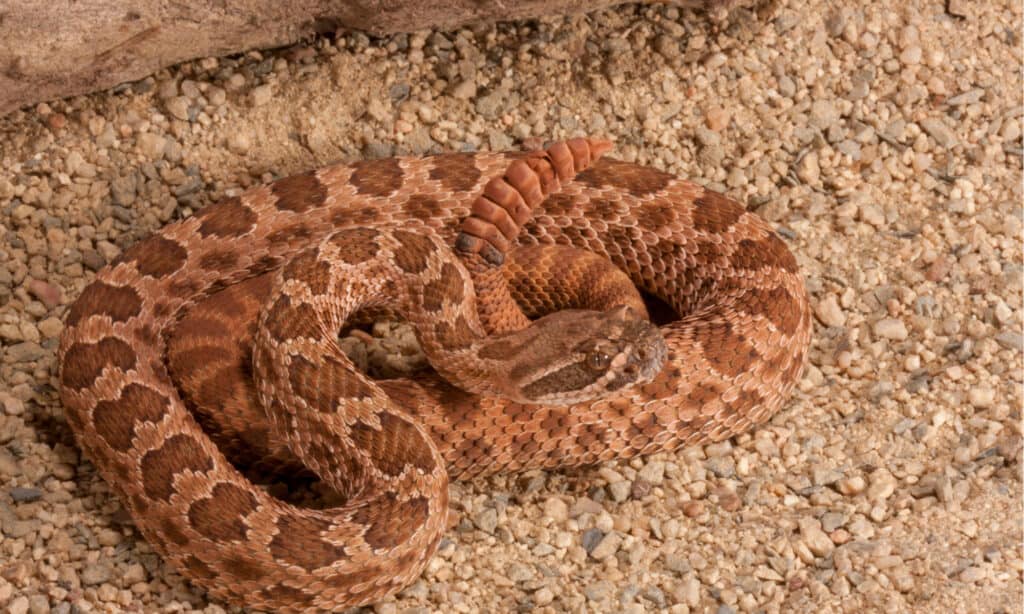
The Hopi Rattlesnake looks like a small prairie rattlesnake.
©K Hanley CHDPhoto/Shutterstock.com
| Hopi Rattlesnake | |
|---|---|
| Range | Southeastern Utah |
| Length | 24 inches |
Hopi rattlesnakes live in southeastern Utah, as well as northwest New Mexico and the desert plateau of northeastern Arizona. The Hopi Rattlesnake is a subspecies of the prairie rattlesnake and is very similar, except smaller, usually around 24 inches long. These rattlesnakes can be orange-brown, gray, or pink, blending in with their surrounding environment. They are patterned with darker brown blotches running down the middle of their backs.
Hopi rattlesnakes are known for being “secretive,” hanging out in rocky crevices or even burrows of other animals to avoid the heat. They emerge early in the morning to hunt rodents, lizards, birds, and occasionally frogs.
Hopi rattlesnakes are generally shy, non-aggressive creatures, but they are quick to attack if they feel threatened or harassed. The venom of the Hopi rattlesnake is primarily hemotoxic, causing swelling and necrosis. Depending on the area, some Hopi rattlesnakes have additional neurotoxins in their venom, causing respiratory issues and muscle paralysis.
The Hopi rattlesnake is a sacred animal to the Hopi Tribe, which is where it gets its name. The Hopi people see these rattlesnakes as guardians of springs and rain. They perform a traditional dance ceremony with the Hopi rattlesnake (without harming it) to help bring rain to the region. Following the ceremony, the people send the snakes back to the wild carrying the prayers of the dancers with them.
6. Midget Faded Rattlesnake (Crotalus concolor)
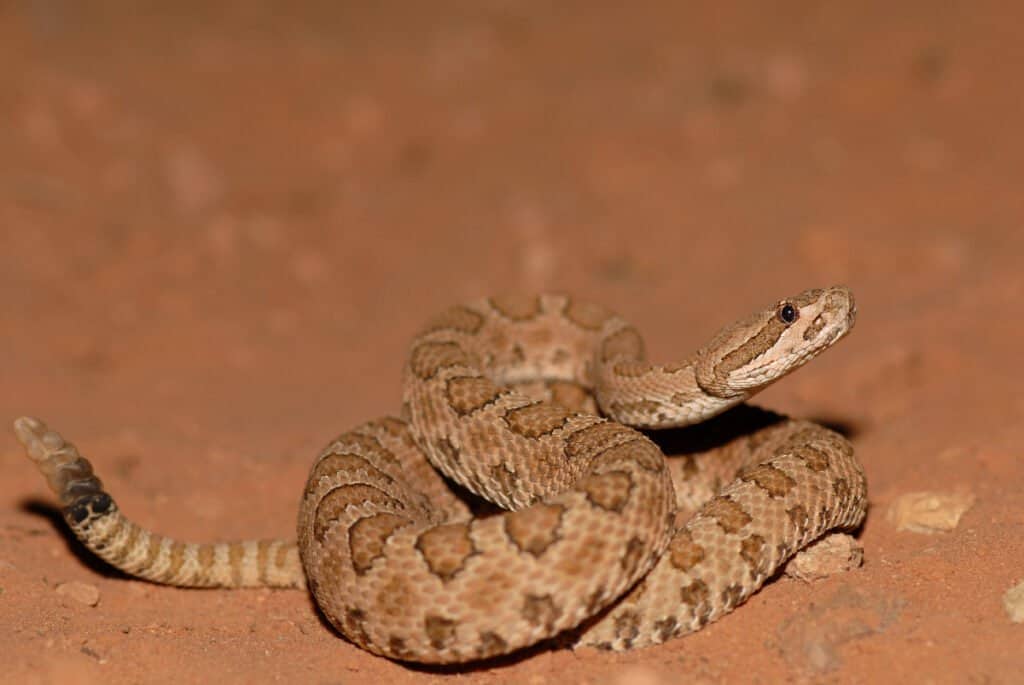
The Midget Faded Rattlesnake’s venom is one of the most potent in North America.
©Rusty Dodson/Shutterstock.com
| Midget Faded Rattlesnake | |
|---|---|
| Range | Eastern Utah |
| Length | 25 inches or less |
The midget faded rattlesnake is found in the eastern part of Utah, as well as in the Colorado River basin, the Green River basin, Wyoming, and some parts of Colorado. These rattlesnakes are smaller than many of the snakes on this list, measuring 25 inches long at the very most.
Midget faded rattlesnakes are pale brown, cream, yellow-brown, or even pinkish in color. They have rectangle blotches with rounded edges running along the middle of their backs, with each blotch outlined in a darker shade of brown. When they are young, midget faded rattlesnakes have brighter, more distinct markings on their backs. As they age, these patterns fade, which is where they get their name. They can become so faded, in fact, that it is hard to tell the difference between this rattlesnake and the ground beneath it!
The midget faded rattlesnake lives in rocky hillside habitats, hunting lizards and other cold-blooded prey. Their venom is extremely toxic, a mix of both neurotoxins and myotoxins that cause paralysis and destroy muscles. The midget faded rattlesnake’s venom is possibly even more poisonous than some cobras.
7. Sidewinder Rattlesnake (Crotalus cerastes)
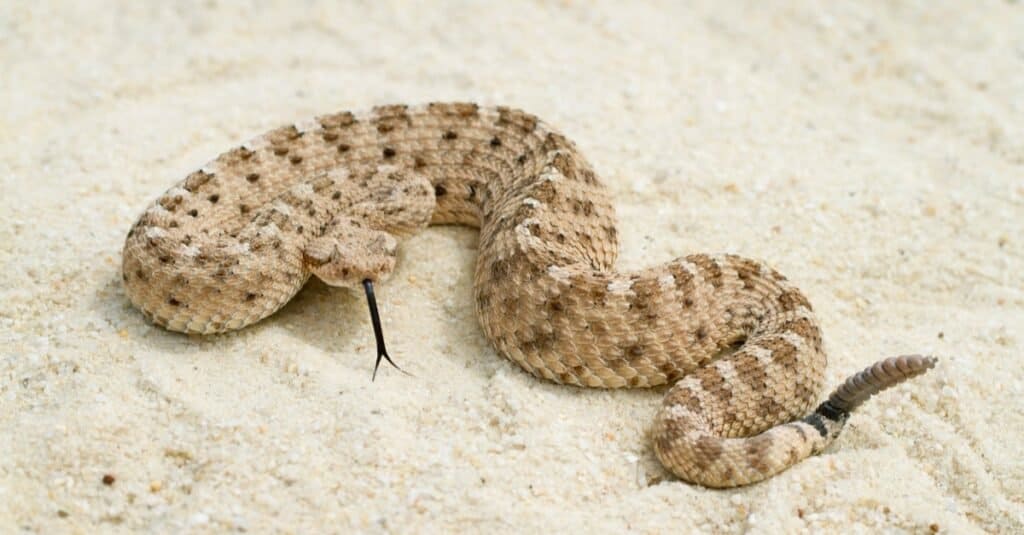
Venomous Sidewinder Rattlesnake (Crotalus cerastes) with forked tongue lying on the desert sand.
©Mark_Kostich/Shutterstock.com
| Sidewinder Rattlesnake | |
|---|---|
| Range | Extreme southwest corner of Utah |
| Length | 17-30 inches |
The sidewinder rattlesnake is found in the extreme southwest corner of Utah, the southwest deserts of the United States, and northwest Mexico. It is one of the smallest species of rattlesnake, measuring between 17-30 inches long. The sidewinder gets its name from how it moves. This rattlesnake slithers in a sideways, winding motion across the sand, leaving J-shaped marks behind. This form of locomotion allows the sidewinder to move up sandy slopes with ease.
Sidewinder rattlesnakes can be light-brownish yellow, cream, yellow-brown, or pink. They have darker, geometric blotches running down the middle of their backs, with smaller patches scattered across their bodies that help them to blend in with the sand. Their most noticeable features are the horn-like scales right above their eyes, which is why sometimes they are called horned rattlesnakes.
Sidewinders bury themselves partially in the sand and wait for their prey to pass by. The venom of sidewinder rattlesnakes is weaker than that of most other rattlesnakes, and their venom glands are smaller. This makes sidewinder rattlesnakes less toxic than others, but it is still dangerous, and you should always stay out of the way of any rattlesnake.
What Other Venomous Animals Live in Utah?
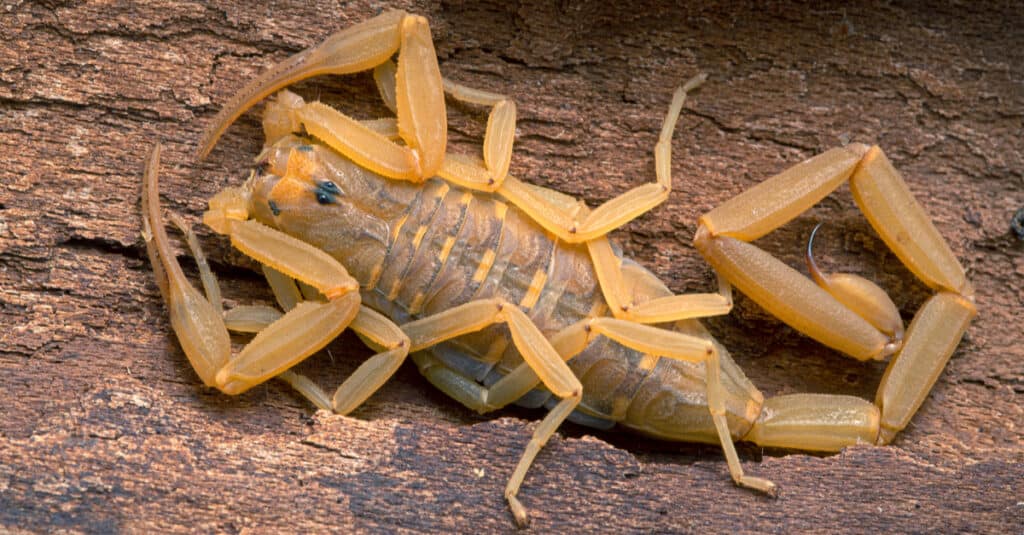
Arizona bark scorpions are the most venomous of their kind in the United States
©Ernie Cooper/Shutterstock.com
The Arizona Bark Scorpion: A small, but incredibly resilient arachnid, this scorpion is found in the southwestern United States and even extends southwards into Mexico. It is capable of measuring slightly over 3 inches and loves to conceal itself beneath rocks to escape the scorching noonday heat. The arachnid also happens to be the most venomous of its kind in the United States. Its sting is known to cause sensations reminiscent of potent electric shocks, tremors, extreme pain, vomiting, nausea, and immobility of the affected part. Symptoms persist between 1 – 3 days.
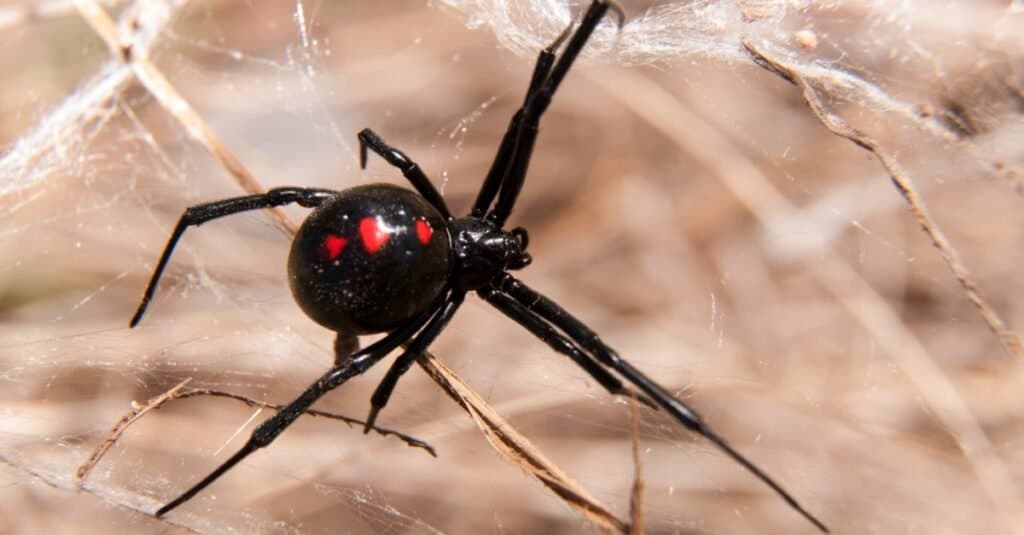
The female western black widow is capable of producing a potent neurotoxin
©Sari ONeal/Shutterstock.com
The Black Widow: The Arizona Bark Scorpion may be the most venomous scorpion in the United States, however, it is far from being the most venomous arachnid. That status belongs to the arthropod otherwise known as Latrodectus hesperus, or the Western Black Widow. The spider which can be found throughout the western United States, possesses a neurotoxic venom that is extremely dangerous for the young, the elderly, and immunocompromised individuals. Victims have reported symptoms that include nausea and pain.
Summary of the 7 Types of Rattlesnakes in Utah
| Index | Species | Location |
|---|---|---|
| 1 | Mojave Rattlesnake | The extreme southwest corner of Utah. |
| 2 | Prairie Rattlesnake | The eastern half of Utah. It is sometimes called the Great Plains rattlesnake, since its range covers most of the Great Plains area of North America, southwestern Canada, and northern Mexico |
| 3 | Great Basin Rattlesnake | Western Utah |
| 4 | Speckled Rattlesnake | The southwestern United States and northwestern Mexico, but it is found only in the extreme southwest corner of Utah. |
| 5 | Hopi Rattlesnake | Southeastern Utah, as well as northwest New Mexico and the desert plateau of northeastern Arizona. |
| 6 | Midget Faded Rattlesnake | The eastern part of Utah, as well as in the Colorado River basin, the Green River basin, Wyoming, and some parts of Colorado. |
| 7 | Sidewinder Rattlesnake | The extreme southwest corner of Utah, the southwest deserts of the United States, and northwest Mexico |
Discover the "Monster" Snake 5X Bigger than an Anaconda
Every day A-Z Animals sends out some of the most incredible facts in the world from our free newsletter. Want to discover the 10 most beautiful snakes in the world, a "snake island" where you're never more than 3 feet from danger, or a "monster" snake 5X larger than an anaconda? Then sign up right now and you'll start receiving our daily newsletter absolutely free.
Thank you for reading! Have some feedback for us? Contact the AZ Animals editorial team.

